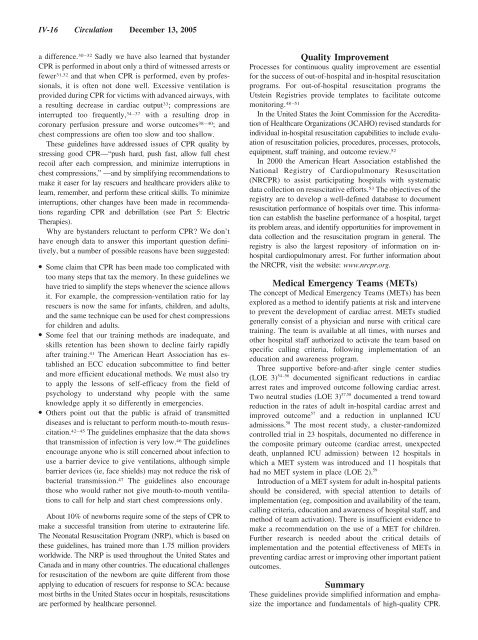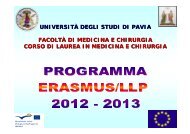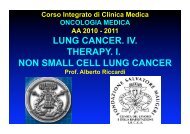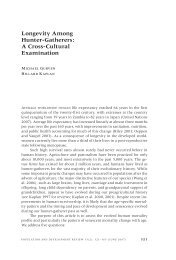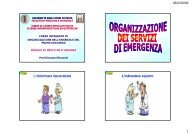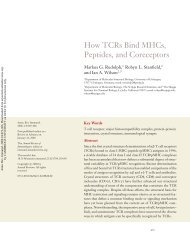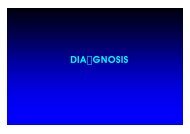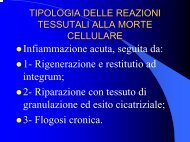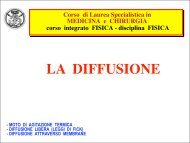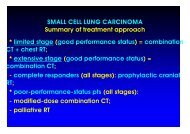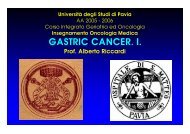Overview of CPR
Overview of CPR
Overview of CPR
You also want an ePaper? Increase the reach of your titles
YUMPU automatically turns print PDFs into web optimized ePapers that Google loves.
IV-16 Circulation December 13, 2005<br />
a difference. 30–32 Sadly we have also learned that bystander<br />
<strong>CPR</strong> is performed in about only a third <strong>of</strong> witnessed arrests or<br />
fewer 31,32 and that when <strong>CPR</strong> is performed, even by pr<strong>of</strong>essionals,<br />
it is <strong>of</strong>ten not done well. Excessive ventilation is<br />
provided during <strong>CPR</strong> for victims with advanced airways, with<br />
a resulting decrease in cardiac output 33 ; compressions are<br />
interrupted too frequently, 34–37 with a resulting drop in<br />
coronary perfusion pressure and worse outcomes 38–40 ; and<br />
chest compressions are <strong>of</strong>ten too slow and too shallow.<br />
These guidelines have addressed issues <strong>of</strong> <strong>CPR</strong> quality by<br />
stressing good <strong>CPR</strong>—“push hard, push fast, allow full chest<br />
recoil after each compression, and minimize interruptions in<br />
chest compressions,” —and by simplifying recommendations to<br />
make it easer for lay rescuers and healthcare providers alike to<br />
learn, remember, and perform these critical skills. To minimize<br />
interruptions, other changes have been made in recommendations<br />
regarding <strong>CPR</strong> and debrillation (see Part 5: Electric<br />
Therapies).<br />
Why are bystanders reluctant to perform <strong>CPR</strong>? We don’t<br />
have enough data to answer this important question definitively,<br />
but a number <strong>of</strong> possible reasons have been suggested:<br />
● Some claim that <strong>CPR</strong> has been made too complicated with<br />
too many steps that tax the memory. In these guidelines we<br />
have tried to simplify the steps whenever the science allows<br />
it. For example, the compression-ventilation ratio for lay<br />
rescuers is now the same for infants, children, and adults,<br />
and the same technique can be used for chest compressions<br />
for children and adults.<br />
● Some feel that our training methods are inadequate, and<br />
skills retention has been shown to decline fairly rapidly<br />
after training. 41 The American Heart Association has established<br />
an ECC education subcommittee to find better<br />
and more efficient educational methods. We must also try<br />
to apply the lessons <strong>of</strong> self-efficacy from the field <strong>of</strong><br />
psychology to understand why people with the same<br />
knowledge apply it so differently in emergencies.<br />
● Others point out that the public is afraid <strong>of</strong> transmitted<br />
diseases and is reluctant to perform mouth-to-mouth resuscitation.<br />
42–45 The guidelines emphasize that the data shows<br />
that transmission <strong>of</strong> infection is very low. 46 The guidelines<br />
encourage anyone who is still concerned about infection to<br />
use a barrier device to give ventilations, although simple<br />
barrier devices (ie, face shields) may not reduce the risk <strong>of</strong><br />
bacterial transmission. 47 The guidelines also encourage<br />
those who would rather not give mouth-to-mouth ventilations<br />
to call for help and start chest compressions only.<br />
About 10% <strong>of</strong> newborns require some <strong>of</strong> the steps <strong>of</strong> <strong>CPR</strong> to<br />
make a successful transition from uterine to extrauterine life.<br />
The Neonatal Resuscitation Program (NRP), which is based on<br />
these guidelines, has trained more than 1.75 million providers<br />
worldwide. The NRP is used throughout the United States and<br />
Canada and in many other countries. The educational challenges<br />
for resuscitation <strong>of</strong> the newborn are quite different from those<br />
applying to education <strong>of</strong> rescuers for response to SCA: because<br />
most births in the United States occur in hospitals, resuscitations<br />
are performed by healthcare personnel.<br />
Quality Improvement<br />
Processes for continuous quality improvement are essential<br />
for the success <strong>of</strong> out-<strong>of</strong>-hospital and in-hospital resuscitation<br />
programs. For out-<strong>of</strong>-hospital resuscitation programs the<br />
Utstein Registries provide templates to facilitate outcome<br />
monitoring. 48–51<br />
In the United States the Joint Commission for the Accreditation<br />
<strong>of</strong> Healthcare Organizations (JCAHO) revised standards for<br />
individual in-hospital resuscitation capabilities to include evaluation<br />
<strong>of</strong> resuscitation policies, procedures, processes, protocols,<br />
equipment, staff training, and outcome review. 52<br />
In 2000 the American Heart Association established the<br />
National Registry <strong>of</strong> Cardiopulmonary Resuscitation<br />
(NR<strong>CPR</strong>) to assist participating hospitals with systematic<br />
data collection on resuscitative efforts. 53 The objectives <strong>of</strong> the<br />
registry are to develop a well-defined database to document<br />
resuscitation performance <strong>of</strong> hospitals over time. This information<br />
can establish the baseline performance <strong>of</strong> a hospital, target<br />
its problem areas, and identify opportunities for improvement in<br />
data collection and the resuscitation program in general. The<br />
registry is also the largest repository <strong>of</strong> information on inhospital<br />
cardiopulmonary arrest. For further information about<br />
the NR<strong>CPR</strong>, visit the website: www.nrcpr.org.<br />
Medical Emergency Teams (METs)<br />
The concept <strong>of</strong> Medical Emergency Teams (METs) has been<br />
explored as a method to identify patients at risk and intervene<br />
to prevent the development <strong>of</strong> cardiac arrest. METs studied<br />
generally consist <strong>of</strong> a physician and nurse with critical care<br />
training. The team is available at all times, with nurses and<br />
other hospital staff authorized to activate the team based on<br />
specific calling criteria, following implementation <strong>of</strong> an<br />
education and awareness program.<br />
Three supportive before-and-after single center studies<br />
(LOE 3) 54–56 documented significant reductions in cardiac<br />
arrest rates and improved outcome following cardiac arrest.<br />
Two neutral studies (LOE 3) 57,58 documented a trend toward<br />
reduction in the rates <strong>of</strong> adult in-hospital cardiac arrest and<br />
improved outcome 57 and a reduction in unplanned ICU<br />
admissions. 58 The most recent study, a cluster-randomized<br />
controlled trial in 23 hospitals, documented no difference in<br />
the composite primary outcome (cardiac arrest, unexpected<br />
death, unplanned ICU admission) between 12 hospitals in<br />
which a MET system was introduced and 11 hospitals that<br />
had no MET system in place (LOE 2). 59<br />
Introduction <strong>of</strong> a MET system for adult in-hospital patients<br />
should be considered, with special attention to details <strong>of</strong><br />
implementation (eg, composition and availability <strong>of</strong> the team,<br />
calling criteria, education and awareness <strong>of</strong> hospital staff, and<br />
method <strong>of</strong> team activation). There is insufficient evidence to<br />
make a recommendation on the use <strong>of</strong> a MET for children.<br />
Further research is needed about the critical details <strong>of</strong><br />
implementation and the potential effectiveness <strong>of</strong> METs in<br />
preventing cardiac arrest or improving other important patient<br />
outcomes.<br />
Summary<br />
These guidelines provide simplified information and emphasize<br />
the importance and fundamentals <strong>of</strong> high-quality <strong>CPR</strong>.


